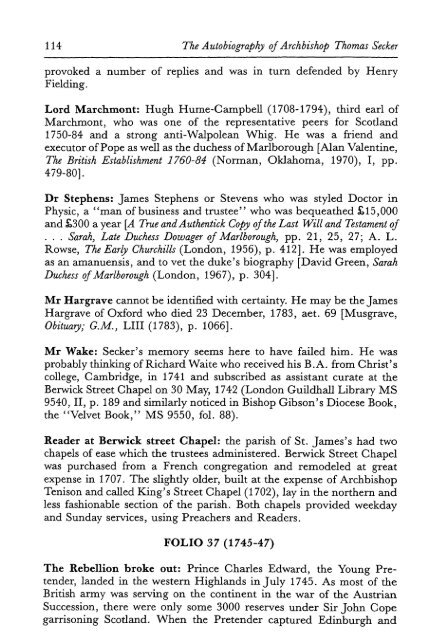Archbishop of Canterbury - KU ScholarWorks - The University of ...
Archbishop of Canterbury - KU ScholarWorks - The University of ...
Archbishop of Canterbury - KU ScholarWorks - The University of ...
You also want an ePaper? Increase the reach of your titles
YUMPU automatically turns print PDFs into web optimized ePapers that Google loves.
114<br />
<strong>The</strong> Autobiography <strong>of</strong> <strong>Archbishop</strong> Thomas Seeker<br />
provoked a number <strong>of</strong> replies and was in turn defended by Henry<br />
Fielding.<br />
Lord Marchmont: Hugh Hume-Campbell (1708-1794), third earl <strong>of</strong><br />
Marchmont, who was one <strong>of</strong> the representative peers for Scotland<br />
1750-84 and a strong anti-Walpolean Whig. He was a friend and<br />
executor <strong>of</strong> Pope as well as the duchess <strong>of</strong> Marlborough [Alan Valentine,<br />
<strong>The</strong> British Establishment 1760-84 (Norman, Oklahoma, 1970), I, pp.<br />
479-80].<br />
Dr Stephens: James Stephens or Stevens who was styled Doctor in<br />
Physic, a "man <strong>of</strong> business and trustee" who was bequeathed £15,000<br />
and £300 a year [A True and Authentick Copy <strong>of</strong> the Last Will and Testament <strong>of</strong><br />
. . . Sarah, Late Duchess Dowager <strong>of</strong> Marlborough, pp. 21, 25, 27; A. L.<br />
Rowse, <strong>The</strong> Early Churchills (London, 1956), p. 412]. He was employed<br />
as an amanuensis, and to vet the duke's biography [David Green, Sarah<br />
Duchess <strong>of</strong> Marlborough (London, 1967), p. 304].<br />
Mr Hargrave cannot be identified with certainty. He may be the James<br />
Hargrave <strong>of</strong> Oxford who died 23 December, 1783, aet. 69 [Musgrave,<br />
Obituary; GM., Uli (1783), p. 1066].<br />
Mr Wake: Seeker's memory seems here to have failed him. He was<br />
probably thinking <strong>of</strong> Richard Waite who received his B. A. from Christ's<br />
college, Cambridge, in 1741 and subscribed as assistant curate at the<br />
Berwick Street Chapel on 30 May, 1742 (London Guildhall Library MS<br />
9540, II, p. 189 and similarly noticed in Bishop Gibson's Diocese Book,<br />
the "Velvet Book," MS 9550, fol. 88).<br />
Reader at Berwick street Chapel: the parish <strong>of</strong> St. James's had two<br />
chapels <strong>of</strong> ease which the trustees administered. Berwick Street Chapel<br />
was purchased from a French congregation and remodeled at great<br />
expense in 1707. <strong>The</strong> slightly older, built at the expense <strong>of</strong> <strong>Archbishop</strong><br />
Tenison and called King's Street Chapel (1702), lay in the northern and<br />
less fashionable section <strong>of</strong> the parish. Both chapels provided weekday<br />
and Sunday services, using Preachers and Readers.<br />
FOLIO 37 (1745-47)<br />
<strong>The</strong> Rebellion broke out: Prince Charles Edward, the Young Pretender,<br />
landed in the western Highlands in July 1745. As most <strong>of</strong> the<br />
British army was serving on the continent in the war <strong>of</strong> the Austrian<br />
Succession, there were only some 3000 reserves under Sir John Cope<br />
garrisoning Scotland. When the Pretender captured Edinburgh and

















